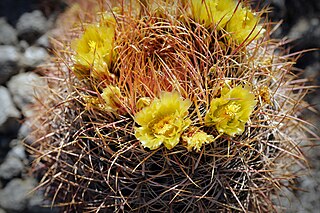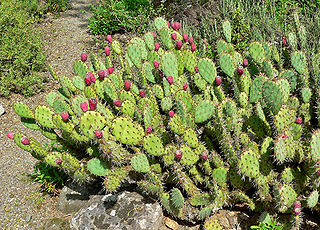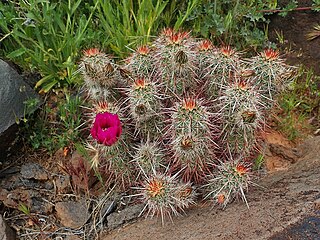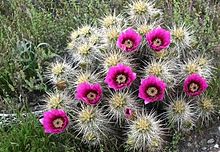
Echinocereus is a genus of ribbed, usually small to medium-sized, cylindrical shaped cacti, comprising about 70 species native to the southern United States and Mexico in very sunny, rocky places. Usually the flowers are large and the fruit edible.

Cylindropuntia is a genus of cacti, containing species commonly known as chollas, native to northern Mexico and the Southwestern United States. They are known for their barbed spines that tenaciously attach to skin, fur, and clothing. Stands of cholla are called cholla gardens. Individuals within these colonies often exhibit the same DNA, as they were formerly tubercles of an original plant.

Opuntia engelmannii is a prickly pear common across the south-central and Southwestern United States and northern Mexico. It goes by a variety of common names, including desert prickly pear, discus prickly pear, Engelmann's prickly pear in the US, and nopal, abrojo, joconostle, and vela de coyote in Mexico.

Echinocereus reichenbachii is a perennial plant and shrub in the cactus family. The species is native to the Chihuahuan Desert and parts of northern Mexico and the southern United States, where they grow at elevations up to 1,500 meters (4,900 ft). This cactus earned the Royal Horticultural Society's Award of Garden Merit.

Ferocactus cylindraceus is a species of barrel cactus which is known by several common names, including California barrel cactus, Desert barrel cactus, compass barrel cactus, and miner's compass. It was first described by George Engelmann in 1853.

Echinocereus triglochidiatus is a species of hedgehog cactus known by several common names, including kingcup cactus, claret cup cactus, red-flowered hedgehog cactus and Mojave mound cactus. This cactus is native to the southwestern United States and northern Mexico, where it is a resident of varied habitats from low desert to rocky slopes, scrub, and mountain woodland. E. triglochidiatus is the official state cactus of Colorado.

Opuntia, commonly called the prickly pear cactus, is a genus of flowering plants in the cactus family Cactaceae, many known for their flavorful fruit and showy flowers. Prickly pear alone is more commonly used to refer exclusively to the fruit, but may also be used for the plant itself; in addition, other names given to the plant and its specific parts include tuna (fruit), sabra, sabbar, nopal from the Nahuatl word nōpalli, nostle (fruit) from the Nahuatl word nōchtli, and paddle cactus. The genus is named for the Ancient Greek city of Opus, where, according to Theophrastus, an edible plant grew and could be propagated by rooting its leaves. The most common culinary species is the Indian fig opuntia (O. ficus-indica).

Mammillaria spinosissima, also known as the spiny pincushion cactus, is a species of flowering plant in the cactus family Cactaceae, endemic to the central Mexican states of Guerrero and Morelos, where they grow at elevations of approximately 1,600 to 1,900 metres. The species was described in 1838 by James Forbes, gardener of the Duke of Bedford. Botanist David Hunt collected a specimen in 1971, when he located one near Sierra de Tepoztlan, Mexico.

Cylindropuntia echinocarpa is a species of cactus known by the common names silver cholla, golden cholla, and Wiggins' cholla. It was formerly named Opuntia echinocarpa.

Echinocereus viridiflorus is a species of cactus known by the common names nylon hedgehog cactus, green pitaya, and small-flowered hedgehog cactus. It is native to the central and south-central United States and northern Mexico, where it can be found in varied habitat types, including desert scrub, woodlands, dry grasslands, and short-grass prairie.

Pediocactus bradyi is a very rare species of cactus known by the common names Brady's pincushion cactus, Brady's hedgehog cactus, and Marble Canyon cactus. It is endemic to Arizona in the US, where it is restricted to Marble Canyon in Coconino County, though its exact distribution is not generally advertised due to poaching concerns. It is limited to a specific type of soil, it has a small distribution, and the species is threatened by a number of human activities. This has been a federally listed endangered species of the United States since 1979.

Ferocactus peninsulae is a barrel cactus in the genus Ferocactus of the family Cactaceae.

Ferocactus emoryi, known commonly as Emory's barrel cactus, Coville's barrel cactus and traveler's friend, is a barrel cactus in the genus Ferocactus.

Cochemiea boolii is a species of cactus in the subfamily Cactoideae with pink-petaled flowers.

Echinocereus fasciculatus, commonly known as pinkflower hedgehog cactus, is a clumping cactus (Cactaceae) with brilliant magenta flowers and long spines found in the Sonoran Desert.

Echinocereus coccineus is a species of hedgehog cactus. Its native to Northern and Central America. It grows on full sun, in sandy or rocky well-drained soil. It can survive in hardiness zones 8–11.

Echinocereus rigidissimus, commonly known as the Arizona rainbow cactus or rainbow hedgehog cactus is a solitary growing cactus that rarely branches or offsets with age.

Echinocereus relictus is a species of hedgehog cactus.

Echinocereus enneacanthus is a species of flowering plant first described by George Engelmann.





















